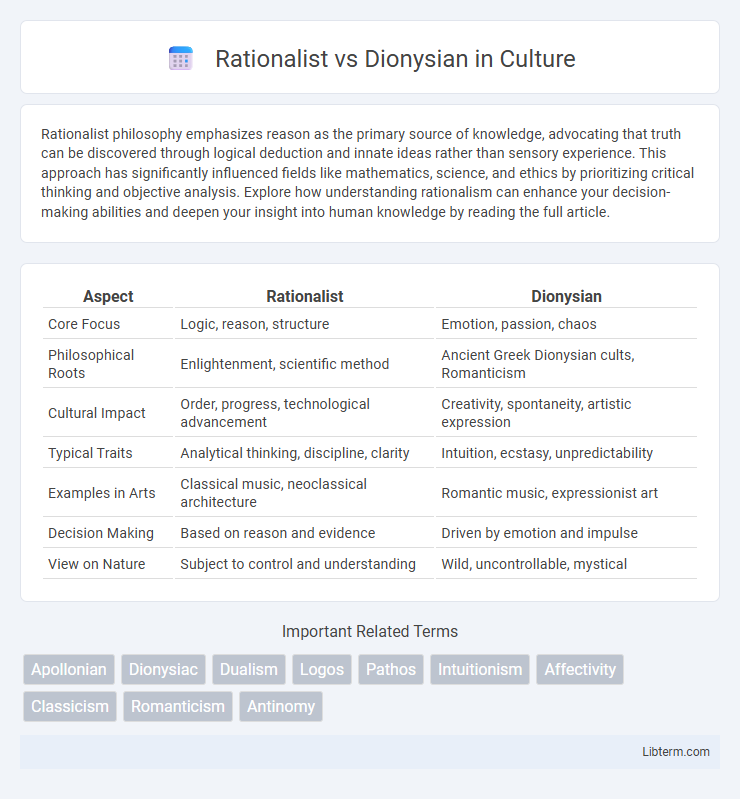Rationalist philosophy emphasizes reason as the primary source of knowledge, advocating that truth can be discovered through logical deduction and innate ideas rather than sensory experience. This approach has significantly influenced fields like mathematics, science, and ethics by prioritizing critical thinking and objective analysis. Explore how understanding rationalism can enhance your decision-making abilities and deepen your insight into human knowledge by reading the full article.
Table of Comparison
| Aspect | Rationalist | Dionysian |
|---|---|---|
| Core Focus | Logic, reason, structure | Emotion, passion, chaos |
| Philosophical Roots | Enlightenment, scientific method | Ancient Greek Dionysian cults, Romanticism |
| Cultural Impact | Order, progress, technological advancement | Creativity, spontaneity, artistic expression |
| Typical Traits | Analytical thinking, discipline, clarity | Intuition, ecstasy, unpredictability |
| Examples in Arts | Classical music, neoclassical architecture | Romantic music, expressionist art |
| Decision Making | Based on reason and evidence | Driven by emotion and impulse |
| View on Nature | Subject to control and understanding | Wild, uncontrollable, mystical |
Defining Rationalism: Logic and Order
Rationalism centers on the belief that reason and logic are the primary sources of knowledge, emphasizing structured thinking and analytical clarity. It values systematic order and objective principles as means to understand reality and solve problems. This approach contrasts with more subjective or emotional ways of knowing, highlighting the power of deduction and empirical evidence.
The Essence of the Dionysian: Emotion and Instinct
The essence of the Dionysian lies in its embrace of raw emotion, instinct, and the unconscious, contrasting sharply with the Rationalist emphasis on logic and order. Rooted in ancient Greek philosophy, Dionysian qualities celebrate chaos, passion, and the primal forces that drive human experience beyond reason. This archetype embodies a holistic connection to nature and the collective psyche, often manifesting through art, music, and ritualistic ecstasy.
Historical Roots: Ancient Philosophies
The concepts of Rationalist and Dionysian stem from ancient Greek philosophy, where Rationalism is linked to the Apollonian ideals of order, logic, and clarity, rooted in the teachings of Socrates and Plato. The Dionysian embodies chaos, emotion, and instinct, attributed to the worship of Dionysus and explored by philosophers such as Nietzsche in his analysis of Greek tragedy. This duality reflects the historical tension between reason and passion in classical thought, influencing Western philosophy's development.
Rationalist Thinkers: Key Figures
Rationalist thinkers such as Rene Descartes, Baruch Spinoza, and Gottfried Wilhelm Leibniz emphasize reason as the primary source of knowledge, advocating for logic, clarity, and systematic doubt in philosophy. Descartes is recognized for his foundational statement "Cogito, ergo sum," establishing self-awareness and rational thought as the basis of knowledge. Spinoza's pantheistic system and Leibniz's theory of monads showcase the depth of rationalist metaphysics, illustrating the commitment to reason over sensory experience.
Dionysian Influence in Art and Literature
The Dionysian influence in art and literature emphasizes emotional intensity, chaos, and the primal aspects of human nature, often manifesting through vivid imagery, mythological themes, and symbolic expressions of frenzy and ecstasy. This creative force challenges rational structure by celebrating irrationality, spontaneity, and the subconscious, inspiring works from Romantic poetry to modern expressionism that delve into existential depths and collective unconscious. Key examples include the passionate dramas of Friedrich Nietzsche, whose "The Birth of Tragedy" outlines the Dionysian as a counterpoint to the Apollonian, and the surrealist movement's exploration of dreams and instincts.
The Apollonian vs Dionysian Dichotomy
The Apollonian vs Dionysian dichotomy represents two fundamental modes of human experience: the Apollonian embodies order, logic, and rationality, while the Dionysian symbolizes chaos, emotion, and instinct. This contrast originates from Friedrich Nietzsche's philosophy, highlighting the tension between structured clarity and ecstatic irrationality. Exploring this duality reveals insights into art, culture, and the human psyche, emphasizing the balance between consciousness and primal forces.
Impact on Modern Culture and Society
The Rationalist perspective, emphasizing logic, order, and analytical thinking, shapes modern society through advancements in science, technology, and structured governance. In contrast, the Dionysian approach champions creativity, emotional expression, and chaos, influencing contemporary art, music, and cultural movements that prioritize intuition and spontaneity. Together, these opposing forces drive cultural evolution by balancing reason with passion in modern cultural and social dynamics.
Rationalism in Science and Technology
Rationalism in science and technology emphasizes logical reasoning, empirical evidence, and systematic methodologies to understand natural phenomena and develop innovations. This approach prioritizes clarity, precision, and reproducibility, enabling advancements in fields such as engineering, computer science, and medicine through structured hypothesis testing and data analysis. Rationalist principles underpin the scientific method, driving technological progress by fostering objective knowledge and efficient problem-solving strategies.
Dionysian Spirit in Music and Performance
The Dionysian spirit in music and performance manifests through ecstatic rhythms, emotional intensity, and a collective experience that dissolves individual boundaries, emphasizing chaos and passion over structured harmony. This approach prioritizes raw, spontaneous expression that evokes primal instincts and a deep connection to nature and the unconscious. In contrast to the rationalist focus on order and form, Dionysian art celebrates the unpredictable, immersive, and transformative power of sensory experience.
Striking a Balance: Integrating Both Perspectives
Striking a balance between the Rationalist and Dionysian perspectives enhances creativity and decision-making by combining logical analysis with emotional intuition. Embracing rational thinking promotes clarity and structure, while incorporating Dionysian elements fosters spontaneity and emotional depth. Integrating both approaches leads to a holistic mindset that fuels innovation and personal growth.
Rationalist Infographic

 libterm.com
libterm.com